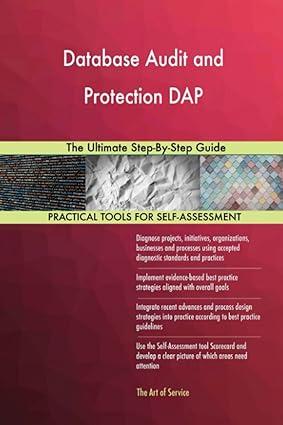Question
The following are various accounts: Indicate whether each of the items below should be classified under IFRS on December 31, 2020, as a current or
The following are various accounts:
Indicate whether each of the items below should be classified under IFRS on December 31, 2020, as a current or long-term liability or under some other classification. Consider each item independently from all others; that is, do not assume that all of them relate to one particular business.
1.
Bank loans payable of a winery, due March 10, 2024 (the product requires aging for five years before it can be sold)
select a classification under IFRS
2.
$10 million of serial bonds payable, of which $2 million is due each July 31
$2 million bonds payable
select a classification under IFRS
$8 million bonds payable
select a classification under IFRS
3.
Amounts withheld from employees wages for income tax
select a classification under IFRS
4.
Notes payable that are due January 15, 2023, where the businesss operating cycle is less than one year.
select a classification under IFRS
5.
Interest payable on a note payable (the note is due January 15, 2023, and the interest is due June 30, 2021)
Interest payable
select a classification under IFRS
Note payable
select a classification under IFRS
6.
Credit balance in a customers account arising from returns and allowances after collection in full of the account
select a classification under IFRS
7.
Bonds payable of $2 million maturing June 30, 2024
select a classification under IFRS
8.
An overdraft of $1,000 in a bank account (no other balances are carried at this bank)
select a classification under IFRS
9.
An overdraft of $1,000 in a bank account (other accounts are carried at this bank and have positive account balances)
select a classification under IFRS
10.
Deposits made by customers who have ordered goods
select a classification under IFRS
Assume instead that the company follows ASPE.
1.
Bank loans payable of a winery, due March 10, 2024 (the product requires aging for five years before it can be sold)
select a classification under ASPE
2.
$10 million of serial bonds payable, of which $2 million is due each July 31
$2 million bonds payable
select a classification under ASPE
$8 million bonds payable
select a classification under ASPE
3.
Amounts withheld from employees wages for income tax
select a classification under ASPE
4.
Notes payable that are due January 15, 2023, where the businesss operating cycle is less than one year.
select a classification under ASPE
5.
Interest payable on a note payable (the note is due January 15, 2023, and the interest is due June 30, 2021)
Interest payable
select a classification under ASPE
Note payable
select a classification under ASPE
6.
Credit balance in a customers account arising from returns and allowances after collection in full of the account
select a classification under ASPE
7.
Bonds payable of $2 million maturing June 30, 2024
select a classification under ASPE
8.
An overdraft of $1,000 in a bank account (no other balances are carried at this bank)
select a classification under ASPE
9.
An overdraft of $1,000 in a bank account (other accounts are carried at this bank and have positive account balances)
select a classification under ASPE
10.
Deposits made by customers who have ordered goods
select a classification under ASPE
Step by Step Solution
There are 3 Steps involved in it
Step: 1

Get Instant Access to Expert-Tailored Solutions
See step-by-step solutions with expert insights and AI powered tools for academic success
Step: 2

Step: 3

Ace Your Homework with AI
Get the answers you need in no time with our AI-driven, step-by-step assistance
Get Started


